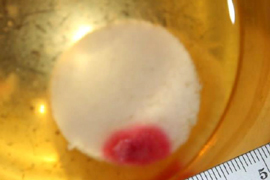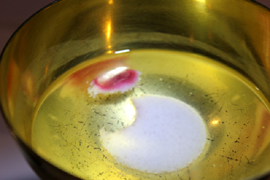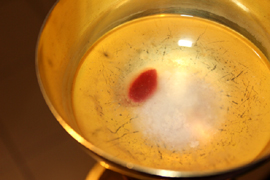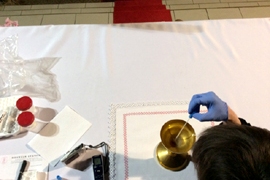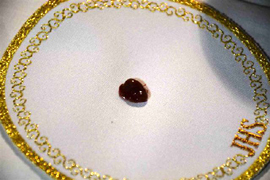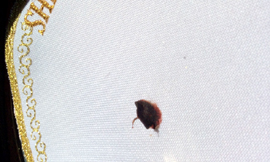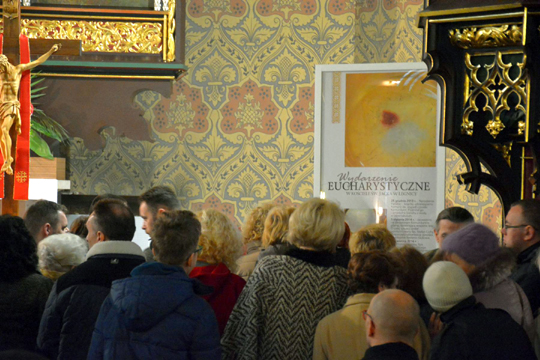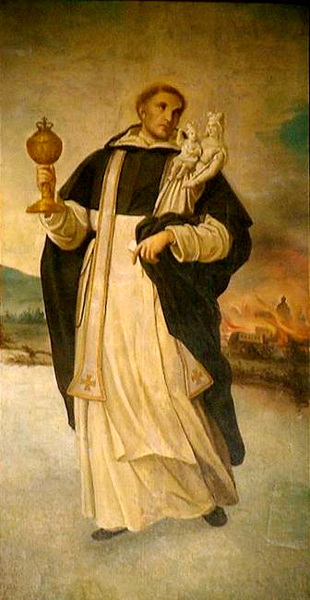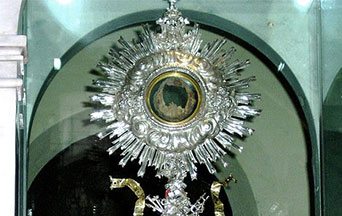 In February 2014, a Host fragment appearing to be bloody tissue was removed from the consecrated Host and placed on a corporal. Samples of this tissue were then taken to be analyzed in laboratories of various forensic institutes. The final statement by doctors of Legnica’s Department of Forensic Medicine concluded that the genetic research indicated the human origin of the tissue, and that “in the fragments of tissue have been found…the fragmented parts of the cross striated muscle…most similar to the heart muscle with alterations that often appear during the agony.”
In February 2014, a Host fragment appearing to be bloody tissue was removed from the consecrated Host and placed on a corporal. Samples of this tissue were then taken to be analyzed in laboratories of various forensic institutes. The final statement by doctors of Legnica’s Department of Forensic Medicine concluded that the genetic research indicated the human origin of the tissue, and that “in the fragments of tissue have been found…the fragmented parts of the cross striated muscle…most similar to the heart muscle with alterations that often appear during the agony.”
The Most Rev. Zbigniew Kiernikowski, Bishop of Legnica, Poland, officially proclaimed that a miracle of the Blessed Sacrament has taken placin the Church of Saint Hyacinth in that city
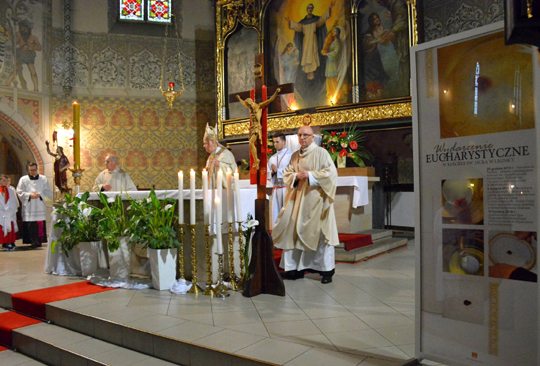 In his decree, he authorized the faithful to adore the bleeding Host, which “has the characteristics that define a Eucharistic miracle,” the site Religion en Libertad reported.1
In his decree, he authorized the faithful to adore the bleeding Host, which “has the characteristics that define a Eucharistic miracle,” the site Religion en Libertad reported.1
The city of Legnica is located in Lower Silesia, in the southwestern part of Poland. The miracle happened during the Christmas Mass of 2013, when a consecrated Host fell to the ground during the distribution of Holy Communion in Saint Hyacinth’s Church.
The Host was collected and placed in a container with water (vasculum) to dissolve, as mandated by wise canonical norms in such cases, and which today are lamentably so often ignored.
But once in the water, a red stain with a unique texture resembling human tissue appeared in the Host.
The Most Rev. Stefan Cichy, then Bishop of Legnica, established a commission to investigate the miracle with the Sacred Host.
In February 2014, with the permission of the diocese, a Host fragment looking like bloody tissue was removed and placed on a corporal. Samples were then collected to be analyzed in laboratories of different forensic institutes.
The final report by the doctors of the city’s Department of Forensic Medicine concluded that “in the histopathological image, the fragments of tissue have been found containing the fragmented parts of the cross striated muscle. (…) The whole (…) is most similar to the heart muscle with alterations that often appear during the agony. The genetic researches indicate the human origin of the tissue.”
Thus, the tests genetically determined that the tissue is of human origin. Doctors also specified that this is a muscle that had suffered stress and suffering, “with changes that often occur during the agony.”
Given the importance of the forensic medical opinions, in January of this year Bishop Kiernikowski submitted the case to the Congregation for the Doctrine of the Faith in the Vatican for theological consideration.
This leading Congregation of the Holy See expressed its support to having the miraculous Host exposed for public adoration and recommended the faithful be given a detailed explanation.
The Host is exposed in a chapel of the sanctuary under the responsibility of the pastor, Fr. Andrzej Ziombrze.
In the document proclaiming the miracle, the bishop stated: “I hope that this will serve to deepen the cult of the Eucharist and will have deep impact on the lives of people facing the Relic. We see the mysterious Sign as an extraordinary act of love and goodness of God…”2
The bishop’s hope is of great importance for our days, when some seek to give the Holy Eucharist to public sinners, ignoring that the Body, Blood, Soul and Divinity of Our Lord Jesus Christ are truly, really and substantially present in the Blessed Sacrament.
On the web site3 of the parish where the miracle occurred there are more photos and explanations in Polish. As per the bishop’s instructions, an open book in the sanctuary collects testimonies of graces received and “other miraculous events.”
Very significantly, the miracle happened in the church dedicated to Saint Hyacinth (1185-1257), called the “Apostle of the North.” The Saint was a Polish Dominican of the thirteenth century, great preacher of the Eucharist and Adoration of the Blessed Sacrament.
In 1240, pagan Mongol hordes invaded the Slav world, then in a process of conversion, devastating cities and fields, and pillaging churches. They attacked the city of Kiev, now the capital of Ukraine, where Saint Hyacinth prayed daily before the Blessed Sacrament.
Knowing that the city would fall into the hands of the barbarians, he took the ciborium containing the Sacred Hosts to flee the city and save the Holy Eucharist from desecration.
Just as he approached the door of the church he heard a loud voice cry out: “Hyacinth, Hyacinth!” To his great astonishment, the Saint perceived that the voice came from the heavy alabaster statue of Our Lady, which was on an altar near the center of the church.
“My beloved Hyacinth,” the voice added,” is it thus you are about to deliver my Son from the hands of the barbarians, and to leave His Mother to their impious insults?”
As the Saint answered that it was impossible for him, who was so weak, to carry a burden which was so heavy, the voice replied: “If you had a little more faith and a little more love for me, it would be very easy for you to carry it.”
“I desire nothing so much as to possess that love and confidence” replied Saint Hyacinth. “See, I am ready to obey at once.”
And indeed, the statue became as light as a feather. Saint Hyacinth then placed both the ciborium with the Blessed Sacrament and the statue of the Virgin under his Dominican cape.
Accompanied by his friars, he miraculously crossed the great river Dnieper, which runs through the city, and passed undetected through the camp of the Mongol barbarians.
Exhausted from his rigorous apostolate and vast journeys founding Dominican monasteries and preaching from Scandinavia to the Black Sea, he spent his final days in his native Poland, where he died in the city of Krakow.
But, long after the end of the Middle Ages, his influence lived on.
Three centuries later, when the Protestants denied the Real Presence of Jesus Christ in the Eucharist and furiously revolted against devotion to Our Lady, the name and images (paintings, pious icons, and sculptures) of Hyacinth multiplied at an amazing pace, even though his canonization process was still under way in Rome.
It was then that the Popes approved the dissemination of devotion to him. He was canonized on April 17, 1594 by Pope Clement VIII. Pope Innocent XI named him Patron Saint of Lithuania.
Saint Hyacinth’s devotees highlight that the above-described Eucharistic miracle was approved by the diocesan bishop on April 17, 2016, the anniversary of the Saint’s canonization.
He is depicted holding a large statue of the Virgin in one hand and a beautiful ciborium with the Holy Eucharist in the other, miraculously crossing the river and the barbarians’ camp.
Saint Hyacinth is widely venerated for his miracles and the heroic example of risking his life to prevent the Holy Eucharist from becoming the object of profanation or sacrilege.


